06 Jan April 2019
Willis Sinclair Homes
“The Lowcountry’s Premier Custom Home Builder”
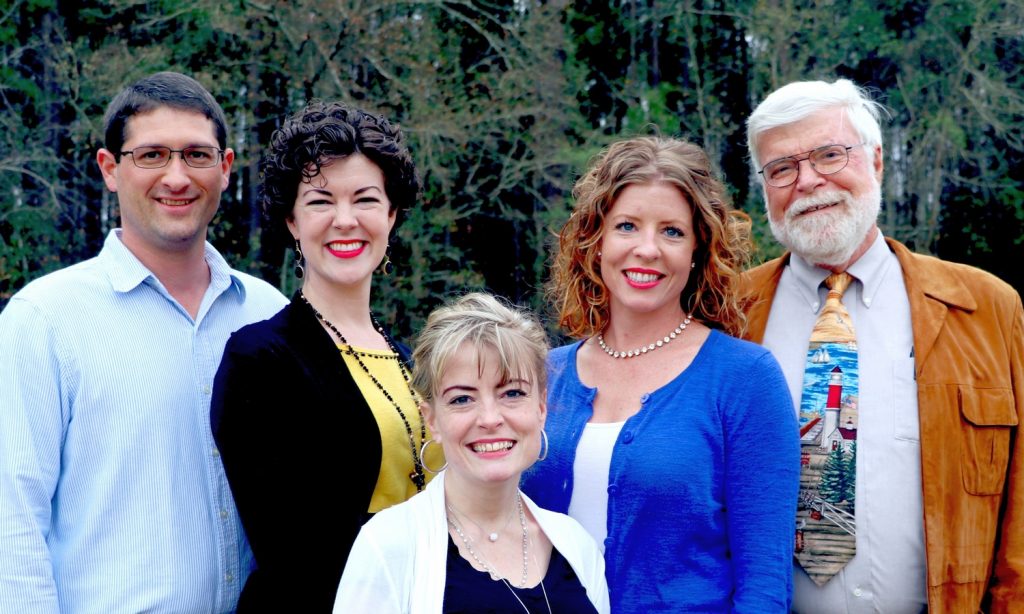
See this photo and read about us in a feature article our newsletter printer wrote: https://www.printplace.com/blog/customer-story-willis-sinclair-homes/
24 Gabriel Road
Lodge, South Carolina 29082
843 846 2500

April 2019
Number 62
 From the desk
From the desk
of Willis …
Hello Everyone! I hope you have had a nice “pollen season” so far! Spring has always been my favorite time of the year, possibly because my birthday just so happens to be in March. It’s also when the days are getting noticeably longer and I am able to work longer to get more done.
2019 looks like it will be another busy and productive year for us. This past year was our best ever since we have been in business. That has been good in a lot of ways but it also leaves us with a very unique challenge. Since we ramped up production to meet the demand we now have the challenge of keeping all of the guys busy that helped us meet that demand. “Use it or lose it” applies to people to and we are anxious to keep our guys gainfully employed.
I say all of that to say that we are glad to take on almost any project that you might have. We are now able to handle many projects at once and welcome them to keep us busy. There is economy of scale that applies when we have an abundance of work. When we have multiple projects to complete we are forced to work more efficiently and quickly in order to meet the demand. The more we have to do the more efficient we have to be. This means that even though we are very busy, we are often able to complete your project in a shorter amount of time. Since time is money that is a benefit to us as well as to our customers.
Before we start a project we like to know as far in advance as possible. This gives us time to plan and schedule the project and line up the right people for the job. By doing a greater volume of work it allows us to keep more people “on tap”. This means we have a larger pool of labor to pull from for our projects. If we know in advance that we will have projects coming then we can keep our pipeline full and keep our guys working.
Prior planning is crucial to the success of any project. The more we plan up front the better the project will flow. If we start with bad plans from an architect then we will be fighting that all the way through construction. Good planning means that we plan out every task, identify every special order item and compile a list of specifications. The more complete the plan is the easier it is to administer the job on site.
If you are thinking of starting a project then don’t hesitate to speak with us about it. The sooner you talk to us the better. If you can be flexible with our start time and work schedule then we can often fit you in between other projects and get you done quicker. Every project has periods of down time and these periods are great times to fit in smaller projects.
So, in conclusions, yes we are busy but we need to be so that we operate most efficiently. Adding your project will just make us that much better!
Windows
Windows are a very important component in a new home. Not only are they expensive, but they can add or subtract from a home’s beauty.
Construction Details
Windows allow light to come in the home and provide the homeowner with beautiful views of the outdoors. Along with the light they allow in and the views they allow out, heat flow also goes both ways (in during the summer and out during the winter).
Heat is transferred through windows in two different ways. One way is conduction. Glass is a poor insulator and heat on one side goes through the glass easily to the other side. One way to slow the flow of heat by conduction is to use two panes of glass (double pane) and fill the void between them with an inert gas such as argon or krypton. These gasses are very poor conductors of heat (good insulators). A quality double pane window will allow only about 10% of the heat through the window.
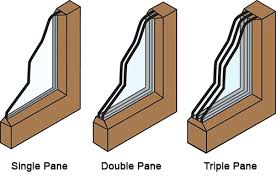
The next question is if two panes are good, are triple panes better? How about quad panes?The answer is yes, but the improvements are small and the disadvantages (heavier, more expensive, thicker, et cetera) quickly add. Double pane seems to be the sweet spot here.
Conduction is one way heat flows through windows. Double panes and inert gas addresses that. Radiation is another important way heat flows through windows. You are experiencing radiant heat energy if you go outside and feel warm from the sun. Radiant energy can go through glass easily. Fortunately there is an easy solution for radiant heat transfer: LowE coating. LowE is a coating put on windows that blocks most of the radiant heat transfer without making the windows very dark.
By using both of these techniques (double pane and LowE), heat flow through windows can be managed well.
Another consideration here in the Lowcountry is the strength of the window. The building code requires windows be impact resistant or that you have a way to protect your windows in case of a storm. The downside of external protection on windows (and doors) is that it has to be installed and then removed as the storm passes through the area.
Windows can be built with a heavy plastic lamination on one of the window panes. An impact window has to be able to withstand a 9 pound 2×4 fired at it at 34 miles per hour. It is fired so the end of the 2×4 hits the window. It is allowed to break, but not penetrate the window.
Impact windows are more expensive than traditional windows, but if you have them, you are always ready for a storm.
Windows also have to withstand wind. The larger the window, the more pressure is on the glass. This is the DP (design pressure) rating of the window. Traditional double pane windows can meet the DP ratings, but not impact ratings.
Aesthetic Details
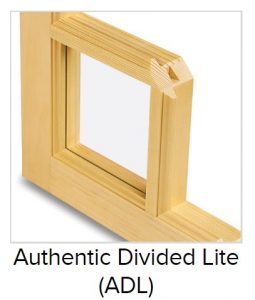
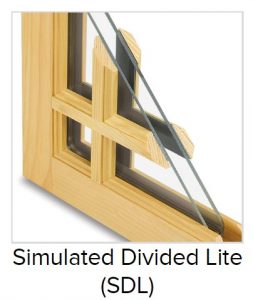 A few years ago, a window was made of individual panes of glass (lights). The panes had a wooden divider between them. They are now called ADL or Authentic Divided Lights. For various reasons, windows are now made with one large pane of glass (or two if double pane). In order to make the large glass window appear to have several panes (or lights), a bit of moulding (muntin) is applied to the outside and inside of the window. These are Simulated Divided Lights (SDL). The number of lights (or SDL patterns) you can have is pretty much unlimited. SDLs can also have a spacer between the panes of glass between the SDL moulding.
A few years ago, a window was made of individual panes of glass (lights). The panes had a wooden divider between them. They are now called ADL or Authentic Divided Lights. For various reasons, windows are now made with one large pane of glass (or two if double pane). In order to make the large glass window appear to have several panes (or lights), a bit of moulding (muntin) is applied to the outside and inside of the window. These are Simulated Divided Lights (SDL). The number of lights (or SDL patterns) you can have is pretty much unlimited. SDLs can also have a spacer between the panes of glass between the SDL moulding.
Lights can be in many different configurations. In addition to just a common 2 lights wide by 2 lights tall, there are a number of unique patterns.
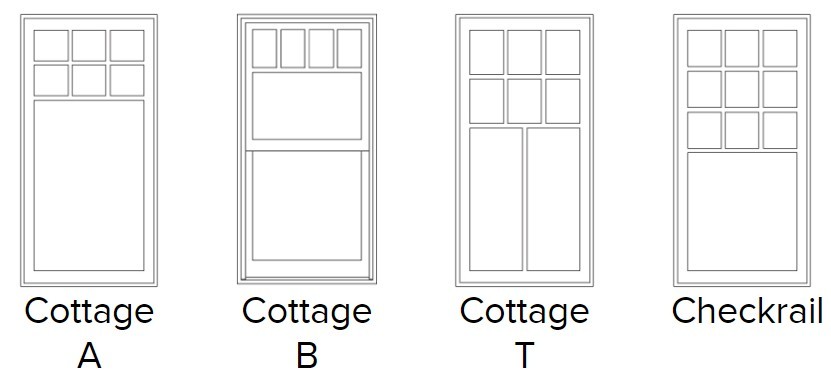
Operational Details
Another thing to consider is how a window opens if it opens. First, some windows don’t open. They are fixed in place and for obvious reasons are called fixed windows.
Probably the most common type of window is a double hung window. It consists of two sashes (or window units): one over the other. The bottom sash will slide up and the upper sash will slide down. Often these sashes are “easily” removable so they can be cleaned on the outside. A variation of a double hung window is a single hung window where only the bottom sash moves. The upper sash is fixed in place.
If you turn a double hung window on its side, you have a slider or a window where the sash(es) slide left or right. They are similar to a sliding door.
There is a group of windows that are hinged and swing either in or out depending on the type of window. If the hinge is on the side (left or right), they are called casement. The unhinged side swings out to open the window.
If a window is hinged at the top and the bottom swings out, it is called an awning window because it is a bit like an awning. Awning windows can be left open in light rains since they shed the water. Of course with a blowing rain, all bets are off.
The last hinge option is the bottom. These windows are called hopper windows. They swing in at the top.
Some casement windows are fixed. A fixed casement window has the same size muntins (dividers) rather than a larger one in the middle like a double or single hung window.
Materials
Window frames on high quality windows are usually wood, aluminum clad wood or perhaps a special fiberglass. Rot here is always a concern, so either aluminum clad or fiberglass exteriors are a good idea.
Confused? Call us. We can help you select the perfect window for your job.
Willis Sinclair Homes
The Lowcountry’s Professional Builder!

Call Us
Willis: 843 599 9056
Abbey: 843 599 2302
Bill: 843 846 2500





No Comments